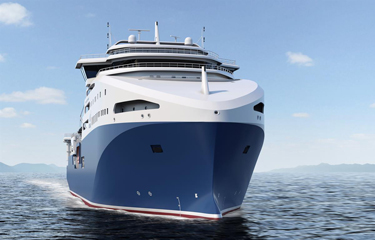An eye-catching new fishing vessel is generating fanfare in China.
At 120 meters in length and 21 meters wide, the Shen Lan was launched in May from a port in Shanghai by Shanghai Chong He Industry Group subsidiary Jiangsu Shen Lan Distant Water Fishing Co. (also known as Jiangsu Sunline Deep Sea Fishery Co. Ltd. or Sunline Fishery). The company aims to increase its krill processing with the new vessel, with the goal of producing human health products such as “blood fat thinning” products, as well as aquafeed.
The Shen Lan is being billed by its owners and the Chinese press as the most modern fishing and processing vessel ever to be built for the Antarctic krill fishery. That has drawn the attention of other Chinese fishing firms, according to Tomaž Nabergoj, director at Helsinki, Finland-based Wärtsilä Ship Design, which led the project.
“Most companies involved in deep-sea fishing in China are aware of the Shen Lan and many of them are also aware that Wärtsilä designed the vessel,” Nabergoj told SeafoodSource. “We have been contacted by some of these owners who would like to discuss potential new builds and conversions.”
In March 2020, Wärtsilä was commissioned to design a second, even bigger, krill processing vessel for the company. There are two to three new krill vessels currently under construction or design in China (including the second Wärtsilä design for the same owner), as well as one additional krill vessel being built in Norway, according to Nabergoj.
“And there are plans in a few other countries, but none under construction as far as I know,” he said.
Yet there are some who believe the Chinese may be overextending themselves, that the Shen Lan is too big and uneconomical for the heavily regulated fishery.
Dmitri Sclabos, managing director of Chilean firm Tharos, which developed a process enabling the extraction of krill oil onboard vessels at-sea in what Sclabos claims is a more environmentally friendly process, said the Shen Lan’s capacity is unnecessary.
“It is like if manhood is being tested,” Sclabos said. “Building a boat able to capture and process 1,000 to 1,300 tons per day [as the Shen Lan is capable of], does it make sense? There are days fishing hits that mark – days you can count with your fingers ... Such an increase in fishing effort will trigger closing more fishing areas to protect the environment, everyone fighting for scarcer resources, NGOs enhancing their surveillance asking for more closures, a potential and severe market backlash, [creating] a cycle difficult to assess at this time.”
Chinese fishing firms have in recent years targeted Antarctic krill (Euphausia superba), with support from local and national government. Antarctic krill biomass for the Southern Ocean has been estimated at around 379 million metric tons (MT), with catch limits managed under the Convention for the Conservation of Antarctic Marine Living Resources (CCAMLR) and currently set at 3.75 million MT. Last year, China and the E.U. inked a marine cooperation agreement that will see them working jointly to protect Antarctic ecosystems.
Despite some changes in the past 45 years in fishing locations, seasonality, and biomass abundance, daily average capture of Antarctic krill has more or less remained similar, Sclabos said.
“If a 200 to 300 MT per day capture was considered reasonable, today over 600 MT per day is the new standard,” he said. “In the 1980s we had years with up to 550,000 tons in annual catch. Now we’re at 300,000 tons per year. We have a TAC [total allowable catch] of eight million tons but a strict precautionary fishing limit of 620,000 tons … Adding all new boats, the math doesn't add up.”
But bigger vessels like the Shen Lan can be more environmentally friendly and sustainable for fish, according to Nabergoj.
“Global fishing activity is closely monitored and strictly controlled by quotas to avoid overfishing. It is a misperception that large fishing vessels empty the oceans. The quota decides the amount of fish, not the vessel size," Nabergoj said. "Therefore, a large vessel which can fish its quota with a limited number of round-trips to the fishing grounds will have less fuel consumption and thereby less environmental impact. Efficiency normally increases with size.”
Wärtsilä Ship Design offers innovative designs with a cost-efficiency focus, Nabergoj said.
“We focus on cost and fuel efficiency, higher energy efficiency, optimized ship-building, lower operating costs, and enhanced environmental performance throughout entire process of [a] new build or retrofit project,” he said.
Krill has become a popular input for pet, livestock, and aquaculture feed, and is also growing more popular as a dietary supplement due to its high omega-3 count. Lured by its benefits, China appears to be taking over the dominant position in the Antarctic krill fishery from Norway, and it now has the most boats fishing in the Southern Ocean for krill. But a recent report from Greenpeace claims growing demand is fueling more commercial fishing in Antarctica, which is in turn endangering polar wildlife, including penguins, which depend on krill for their survival.
“We have a healthy krill fishery, very well-managed by CCAMR, and we should protect it for the years to come,” Sclabos said. “Over-stretching our ability to capture all what’s in there is not, in my opinion, good for the long-term; financially, marketwise, for investors, or for operators.”
Photo courtesy of Wärtsilä Ship Design Co.







